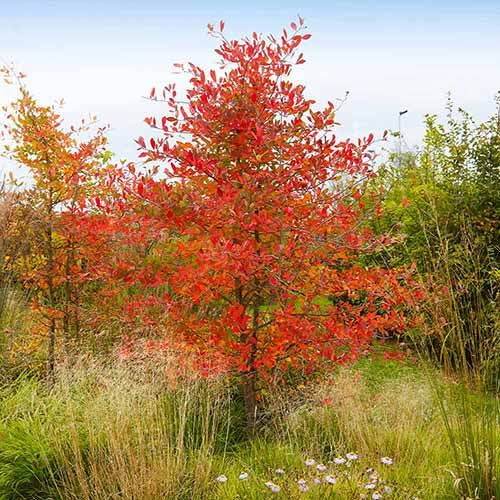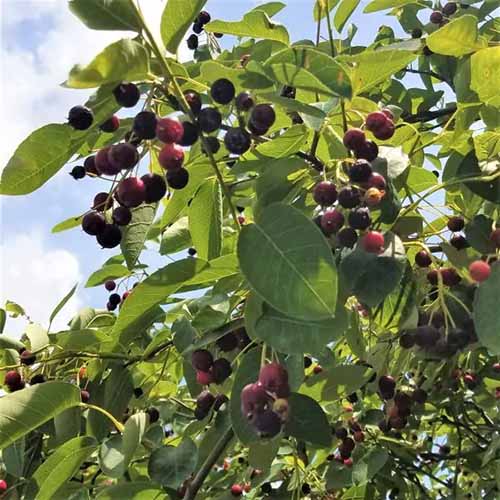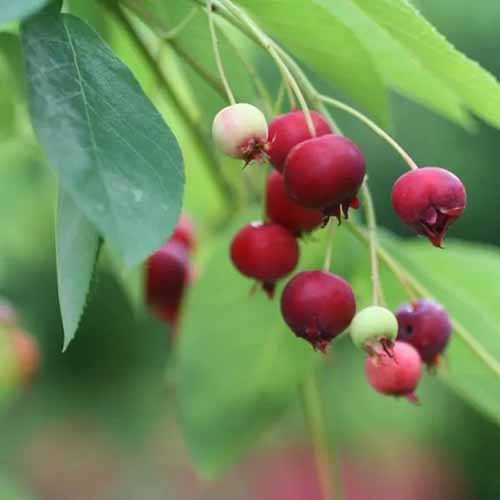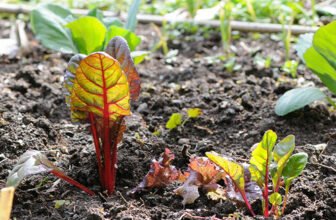
[ad_1]
Amelanchier spp.
The starry white blossoms of the serviceberry are like an event marked on nature’s calendar, a signal for spring and the awakening of life in our gardens after the winter slumber.
As summer unfolds, the clusters of blossoms give way to an abundance of sweet, purple fruits that are a secret treat among birds, foragers, and berry aficionados alike.
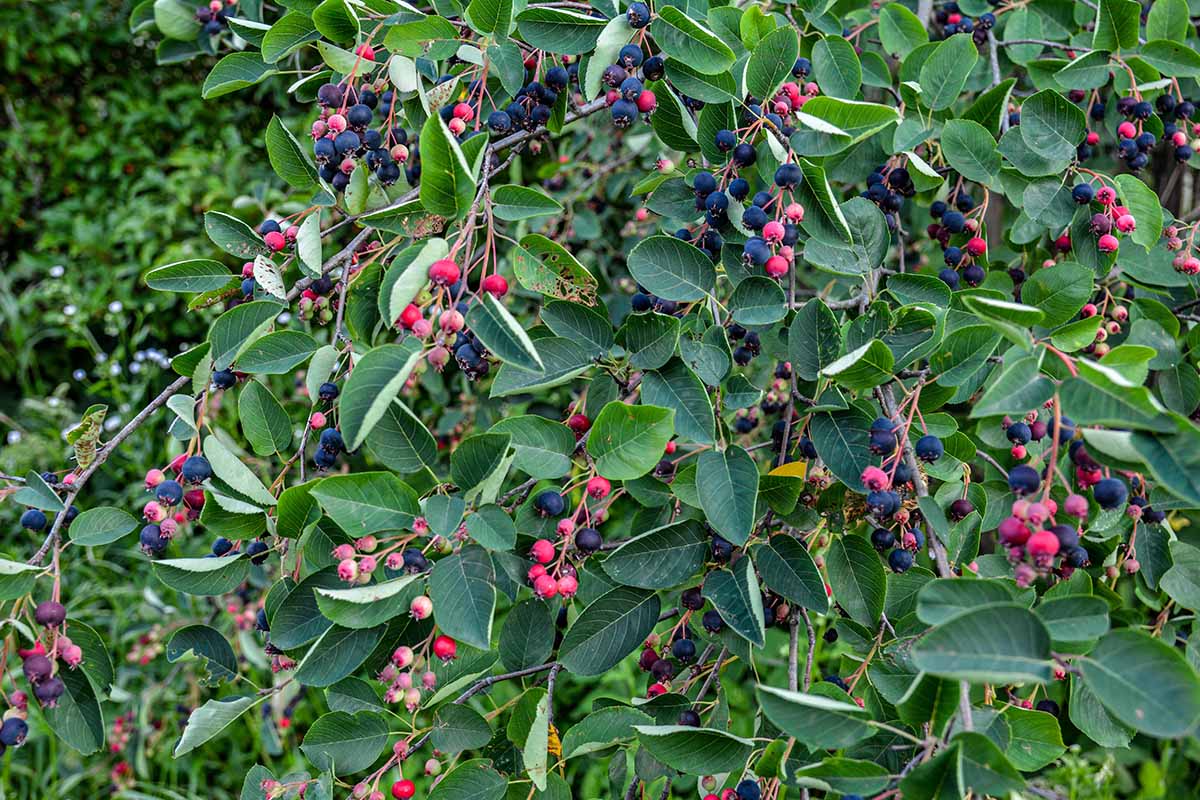

We link to vendors to help you find relevant products. If you buy from one of our links, we may earn a commission.
To me, the serviceberry is like a charming protagonist in the story of the forest, a provider of life and a main character in tales told by foragers and urban farmers alike.
This guide will not only acquaint you with the ins and outs of growing and these delightful trees and shrubs, but might also inspire you to create your own tales with their versatile and delightful fruits.
Here’s a look at what I’ll cover in this article:
Now, if you’re ready to learn more about serviceberries, let’s get to it!
What Are Serviceberries?
Amelanchier is a genus of about 30 accepted species of flowering deciduous trees or large shrubs, native to northern Africa, Asia, Europe, and eastern North America.
It’s part of the Rosaceae family, sharing kinship with apples and roses.
Species within the genus are known by various names, including chuckley pear, downy serviceberry, Juneberry, Junebush, shadbush, shadblow, sarviceberry or sarvisberry, sugarplum, wild pear, and wild plum.
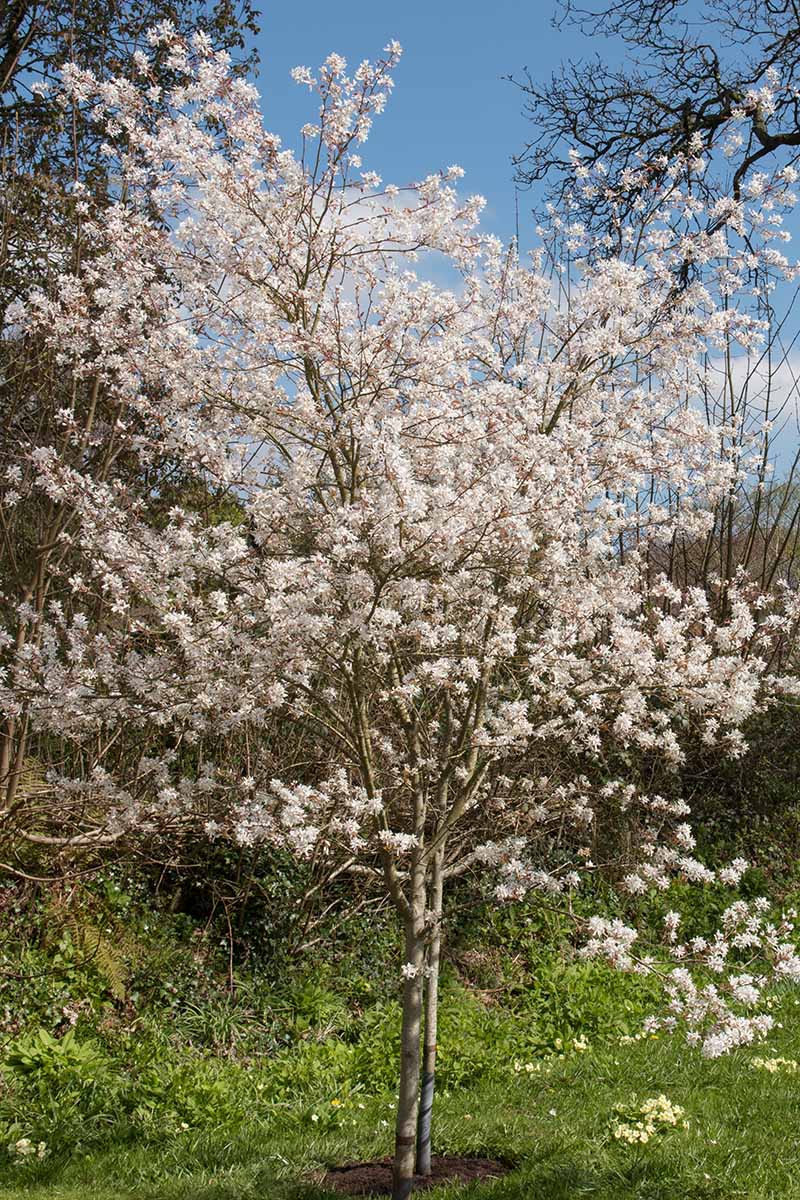

Different Amelanchier species can often be found growing in the same regions and hybridization is common in the wild, so even botanists and those researching in the field are often stumped during the identification process.
Nearly two dozen species can be found growing wild and cultivated in different parts of the United States and Canada, including the popular A. arborea, often called downy serviceberry; A. canadensis, known also as shadblow or shadbush; A. x grandiflora, cultivated and natural hybrids between A. arborea and A. laevis, often called apple serviceberries; and A. laevis, commonly known as Allegheny serviceberry.
Serviceberries thrive in USDA Hardiness Zones 2 through 9 and have a wide geographical range in North America.
The appearance of serviceberry shrubs and trees evolves through the seasons, offering year-round interest.
In spring, they welcome the season with showy, slightly fragrant, five-petaled, white flowers before the leaves emerge.
The leaves are simple, alternate, and finely-toothed, turning into a splendid display of fall colors in glorious golds, vibrant oranges, and many shades of red.
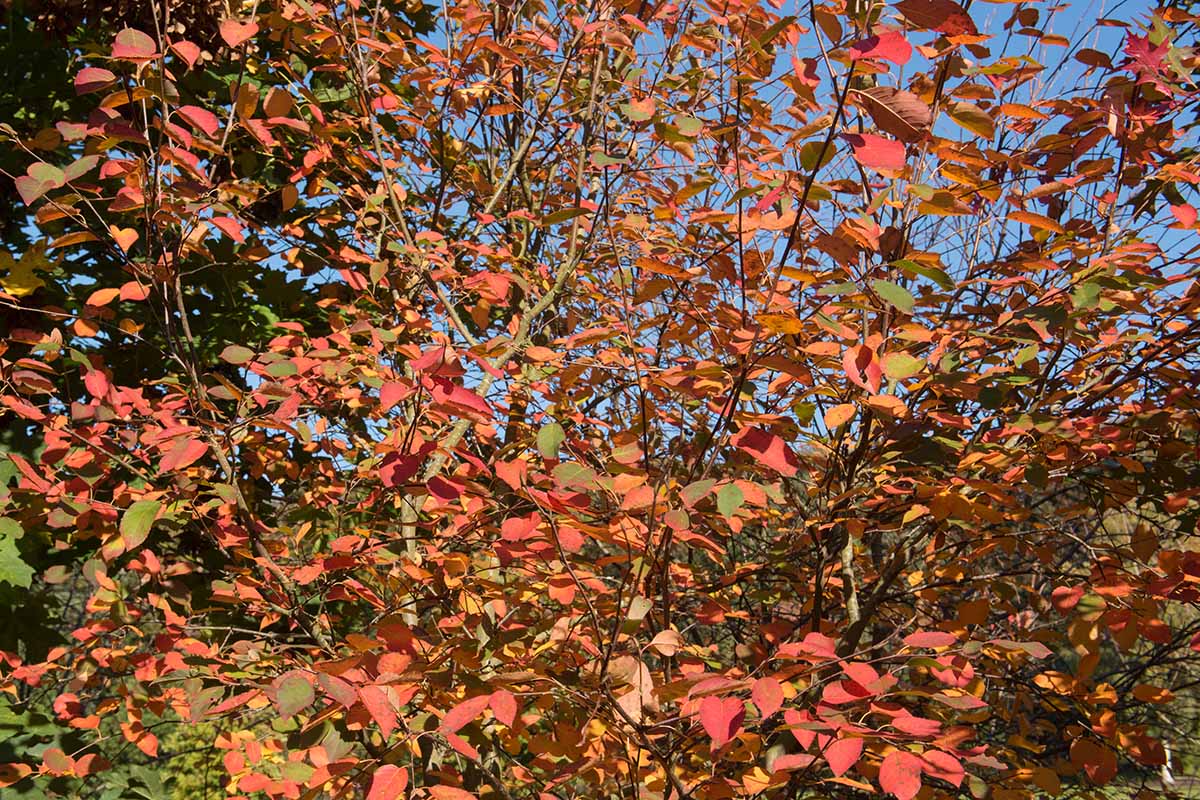

In winter, the structure of the leafless, bare stems and trunks provide a stark, elegant silhouette against the snowy landscape.
The berry-like fruits, emerging in spring and ripening from green to red and finally to a dark purplish-black in early summer, resemble blueberries in their size and color.
They are all edible, but those of A. alnifolia, A. canadensis, A. oblongifolia, and A. spicata are considered the most flavorful. They are favored for use in jams, jellies, and pies, and are also a vital food source for wildlife.
Serviceberries begin to produce fruit when they reach three to five years in age, and the yields will gradually increase, reaching full production when the plant is about eight years old.
With their adaptability to a range of soil types, including light sandy, loamy, and heavy clay soils, and preference for moist, well-drained conditions, serviceberries are a versatile and beautiful addition to many landscapes.
Additionally, they are tolerant of juglone so can be safely planted near black walnut trees.
Cultivation and History
The botanical history of the genus is marked by classification challenges and hence, name changes.
An account of the serviceberry is recorded as far back as 1789 by Friedrich Medikus. The genus was later revised and expanded in Wiegand’s monograph in 1912. Further clarifications were made by Fernald in 1941.
Subsequent modifications and reclassifications of species within the genus have been made over the years, and botanists and taxonomists still disagree over many proposed additions to the list of species.
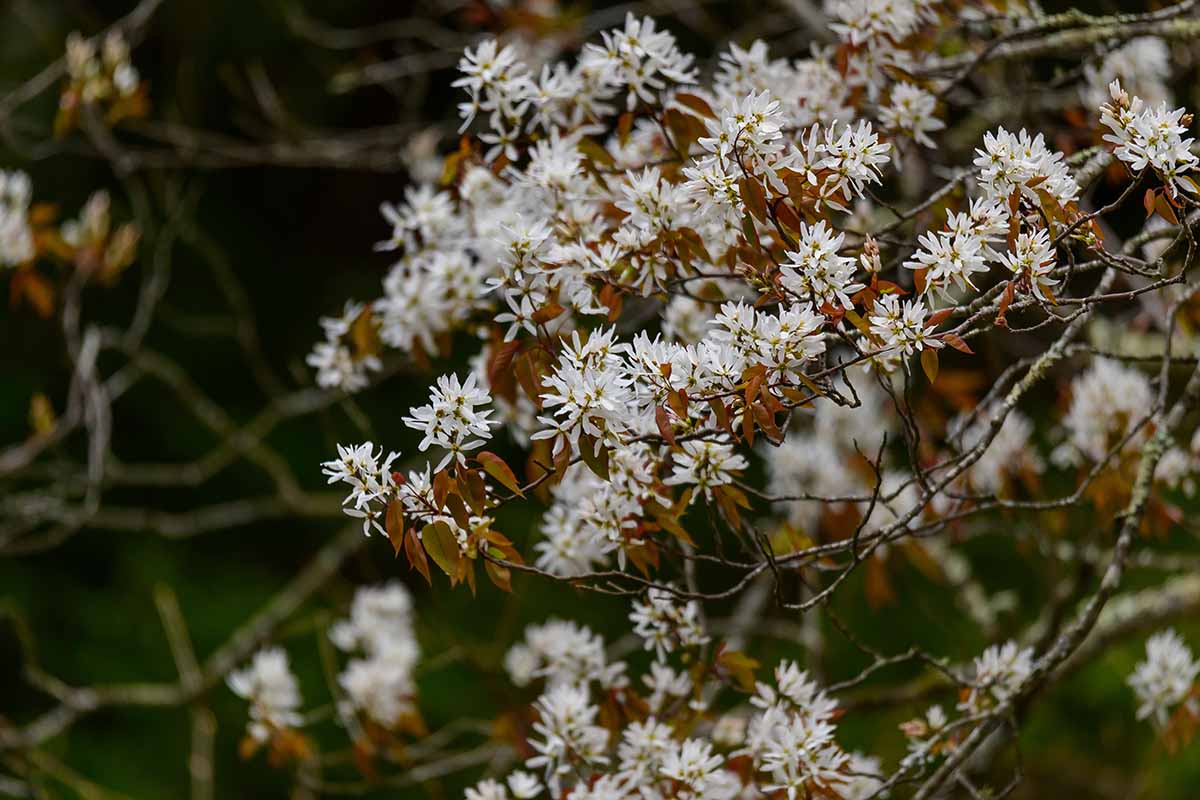

Geographically, the consensus among botanists is that the serviceberry can be found growing natively or wild in all parts of the United States except Hawaii, as well as all provinces of Canada.
While serviceberries are predominantly found in North America, their popularity as ornamentals has led to cultivation in other parts of the world, particularly in Europe.
In non-native regions, the serviceberry is primarily found in cultivated settings like gardens and parks, rather than growing wild.
The cultural history of the serviceberry is rich and diverse. The name “service” is linked to the time of year the trees bloom in areas of the Appalachian Mountains.
When the flowers opened, it was a signal that the muddy back roads that had been impassible over winter could again be traversed, allowing for circuit-riding preachers to hold their Sunday services again.
Some plant historians believe the real origin of the name serviceberry comes from a Proto-Indo-European stem word “sor,” or “sorbus,” which refers to the red color of the fruits, and this word pre-dates other stories associated with the name serviceberry.
Known as “shadberries” in New England, the spring blossoms coincide with the shadfish runs.
The edible fruit of serviceberry has long been a staple in local culinary traditions, used in pies, preserves, and fermented wine.
Native Americans used the berries to make bread. Culinary use has evolved over the years and the berries are now being incorporated into more modern dishes.
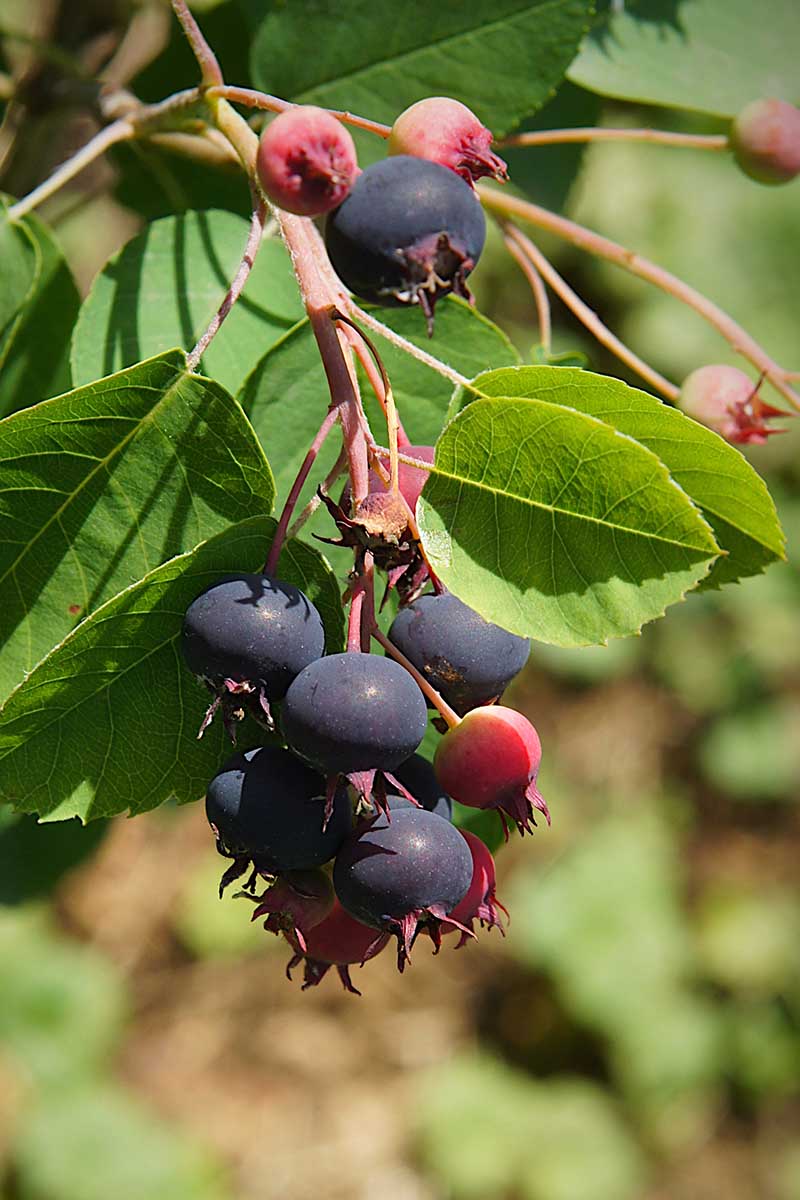

Today, serviceberry shrubs and trees are commonly available at local nurseries and garden centers. Their appeal extends beyond their historical and cultural significance, and serviceberries have become a popular ornamental for landscaping.
Thanks to their ease of care and early, cheerful spring blossoms, serviceberries are appreciated by horticulturalists for their ornamental value in gardening and landscape design.
As native species, they add biodiversity to smaller-scale ecological systems, appealing to urban farmers and those interested in food forest cultivation.
Now let’s take a look at how to grow serviceberries, beginning with propagation.
Serviceberry Propagation
Serviceberries can be propagated from seed, from cuttings, by removing and transplanting suckers, and by transplanting purchased container-grown plants from nurseries and greenhouses.
From Seed
Propagating from seed can be a slow and uncertain process, as the seeds have a hard outer coat that requires stratification, which is a period of cold treatment, to break dormancy.
This method is not recommended as it can take a long time for seeds to germinate and grow into mature plants. Additionally, seeds collected from hybrids will not grow true to the parent plant.
If you’re motivated to try and you’ve got the time required to do so, there are a few things you should know.
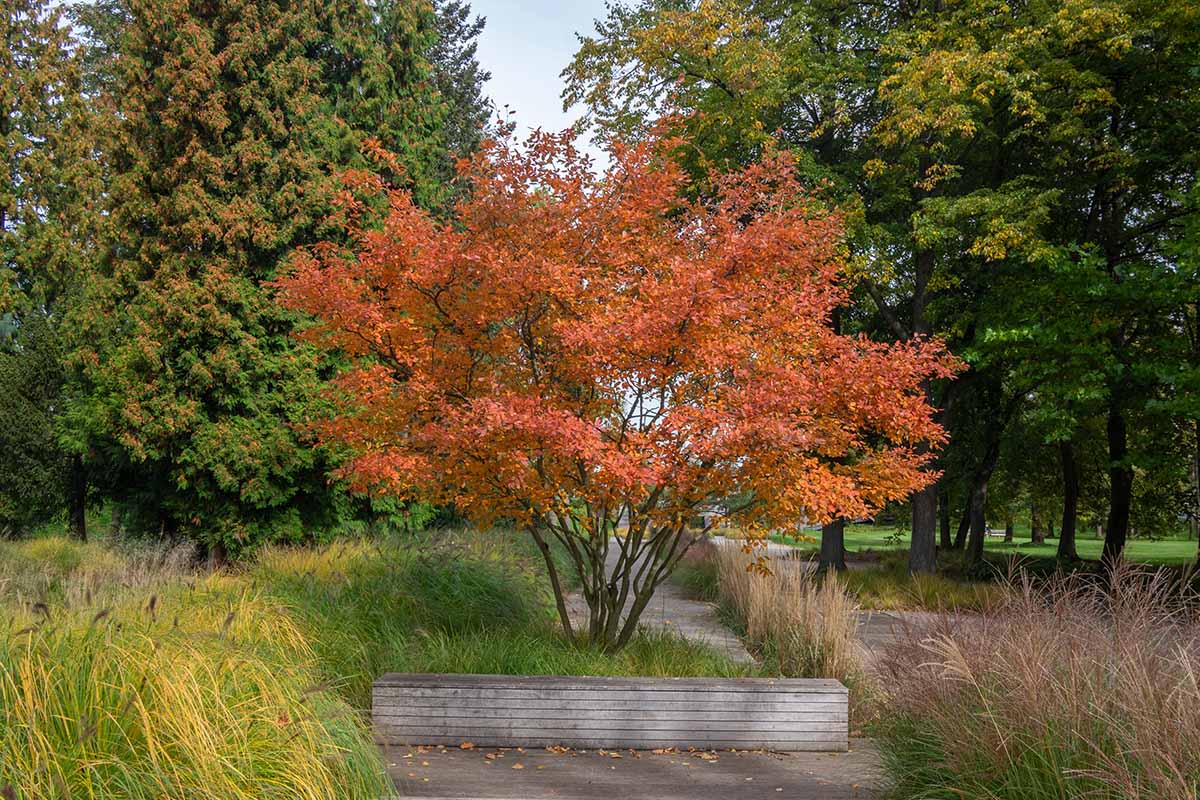

The seeds should be harvested when they are fully developed but before the seed coat hardens.
This means that if you can beat the birds to them, you should collect the fruits when they’re ripe.
To extract the seeds, macerate the berries and wash them over a mesh screen. Seeds can be sown immediately in pots outdoors or in a cold frame.
Alternatively, they can be sown in an outdoor seedbed. This is best done in the fall because cold stratification will happen naturally this way.
Seeds can be kept for up to five years if you air-dry them.
Before sowing, the stored seeds will need a period of cold stratification. To do this, place the seeds in a plastic baggie with moist peat moss and set them in the refrigerator for 120 days.
Seeds can be very slow to germinate, sometimes taking 18 months or more.
Once germinated and large enough to handle, seedlings should be transplanted into individual pots and grown in a sheltered outdoor location until they are at least seven inches tall, when they can be transplanted into the garden.
If this method of propagation doesn’t seem appealing to you, let’s investigate the other ways to get started.
From Cuttings
To propagate serviceberry from semi-hardwood cuttings, begin in late summer by selecting a healthy stem from the current season’s growth, ensuring the base is hard but the tip remains soft.
You can take softwood cuttings in late spring or early summer.
Take a six-inch-long cutting, making your cut just below a leaf node. Strip the leaves from the bottom half of the cutting and then remove the soft tip growth.
You should be left with a length of stem about four to six inches long with three or four leaves at the top.
Dip the base of the cutting in hormone rooting powder and insert it into a container filled with a free-draining mix of potting soil and sharp sand or perlite.
Water the cuttings, then place them in a greenhouse or cover the container with a plastic bag and set it in a warm spot that is brightly lit but out of direct sunlight.
Maintaining moisture is key while the roots are developing, so monitor moisture levels and water consistently. Roots should begin to form after about six to eight weeks, sometimes a little longer. Keep checking the cuttings for root development and maintain consistent moisture throughout.
Ideally, for late summer cuttings, they have sufficiently rooted through the winter and can be planted out in early spring after hardening off.
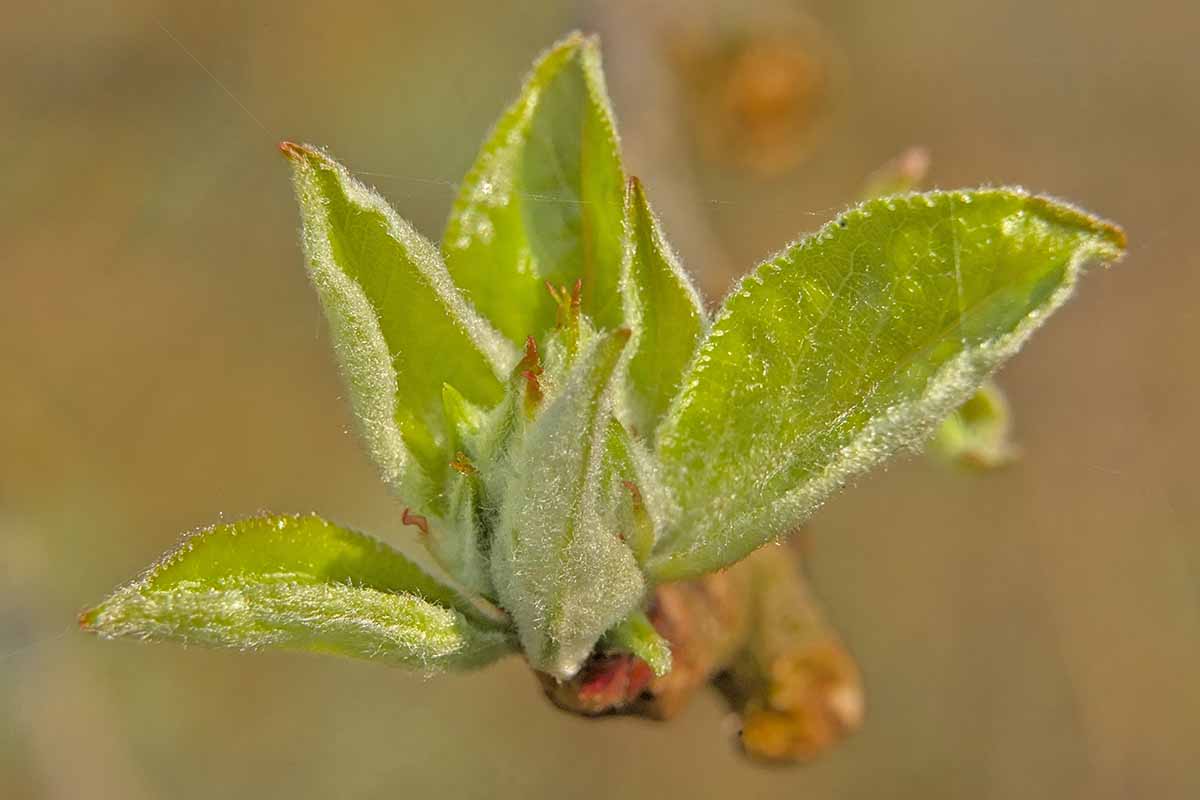

Hardwood cuttings can be taken during the dormant season, typically from mid-autumn until late winter, after leaf fall and before spring buds open.
Select vigorous, healthy shoots from the current year’s growth, and take a cutting that’s at least six inches long. You can take longer cuttings and then cut the shoot into multiple sections if you wish.
With your freshly cut shoot, clip off the soft tip growth. Then cut it into six- to 12-inch long sections, at a 45 degree angle above a bud. The length of your cuttings might vary depending on the length of the material you’re working with.
At the base of each cutting, cut straight below a bud. Dip the base in a rooting hormone.
In a sheltered outdoor trench with well-draining soil mixed with organic matter, insert the cuttings about one-half to two-thirds below the surface, spaced about 16 inches apart.
Aim to bury a few buds beneath the soil and leave a few buds above the soil. Depending on the length of your cuttings, this could be about three to six inches below the soil.
These cuttings, left in the ground over winter, should form roots by spring.
Alternatively, hardwood cuttings can be kept in pots in a cold frame or unheated greenhouse until the following year before planting out in your garden. If you do this, be sure to keep the soil moist and don’t let it dry out.
Suckers
Digging up and transplanting suckers is an easy and low-cost way of producing more plants, and like cuttings, they are clones of the parent plant.
Suckers grow from the root systems, at the base of the plants. They can be removed and transplanted when they have formed their own roots.
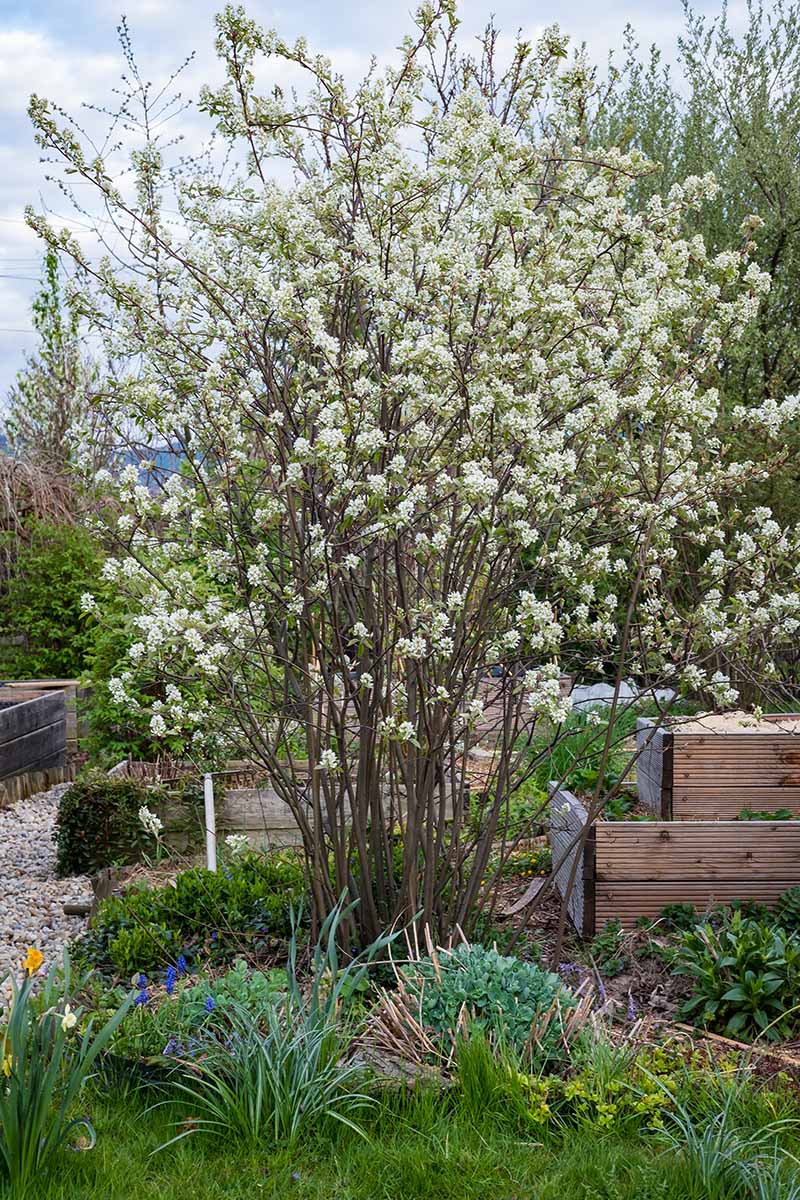

The best time to divide suckers is in the spring when the plant is directing energy into new growth. Choose large, developed suckers with their own established root systems.
To separate a sucker from the main plant, dig the soil away from the area around the sucker before working to expose the roots.
Separate it from the main plant by cutting through the roots with a clean knife or sharp shovel. Once you’ve dug it up, you can transplant it to a new location as discussed below.
Transplanting
You can purchase potted specimens from reputable nurseries for transplanting into the garden. This is a reliable way to ensure you are receiving and planting a healthy specimen.
To transplant, dig a hole in well-drained soil twice as wide and just as deep as the root ball. It’s always a good idea to add a scoop of compost into the hole or mix it in with the backfill to provide nutrients for young plants.
Because serviceberry is a hardy native, however, it’s not entirely necessary, so don’t go out of your way to purchase compost specifically for this purpose.
If you’re planting food-producing serviceberries like Saskatoons, and you want to give your new plant the best possible environment to become established, then go for it!
With all my transplants, especially trees and shrubs, I like to incorporate mycorrhizal fungi into the soil to help ensure plants have a successful transition to their new home.
One of my favorite products is Root Build 240, available from Arbico Organics.
Learn more about the benefits of using soil inoculants in our guide.
When you’ve got your hole dug and your inoculant in hand, the next thing to do is remove your plant from its pot. Squeeze the container to loosen the roots, then slide the plant out.
Take a good look at the root ball and remove any damaged or dead roots. If the roots are bound or wrapped tightly, tease them apart with your fingers.
If you’re using an inoculant, follow the instructions on the package and add the product to the planting hole.
Set your plant into the hole, adjusting it so that the top of the root ball is at the same level it was in its original container. You may need to dig the hole a little deeper or add some soil back in to get it just right.
After you remove a plant from a container and tease tight roots apart, the size of the root ball can become larger than it first appears.
Be sure the roots have enough room to spread out naturally without crowding and dig the hole a little larger if you need to. Don’t force it into a hole that’s too small!
Then backfill the hole with soil, tamping gently as you fill in around the roots.
Give your plant a big drink of water. I recommend adding a three- to four-inch layer of mulch to the base of the plant, covering the root zone. Be sure to keep the mulch from touching the young trunk or stems to avoid potential rot.
Then step back and admire your work! Now that you’re familiar with how to plant your serviceberry, let’s discuss all of its growing needs.
How to Grow Serviceberries
As with many native plants, serviceberries are pretty easygoing in their natural habitat. Let’s explore how you can ensure the best growing conditions and how to care for these plants in more depth.
Serviceberries are a good choice for landscape designs and home gardens in USDA Zones 2 to 9.
They thrive best in full sun to part shade, so choose a spot where your plants can see the sun for at least half of the day.


These trees or large shrubs prefer well-drained soil with a pH range of 5.5 to 7.0. They do best in either loamy or sandy soils, but they can tolerate clay soils, too.
So, if you’re challenged with a clay planting site, serviceberry is a good choice for you.
These trees and shrubs are slow-growing, reaching their maximum size after 10 to 20 years.
Space your plants according to the expected maximum height and spread of the species you have selected.
For taller specimens, plant them far enough away from canopies of nearby trees that they will have room to grow.
Unless you plan to control the size of the plant by pruning regularly, allow for enough room around it to accommodate the space it needs to grow to its mature width.
As native plants, in their natural habitat, serviceberries do fine with the amount of water they receive through rainfall.
But to cultivate the healthiest, most productive plants in your ornamental garden or orchard, they may require supplemental watering. This is especially true if you want the most abundant berry harvest.
Serviceberries prefer the soil to be consistently moist but not waterlogged. So what does this mean? Check the soil!
Stick your finger into the soil about two to four inches, or as deep as your finger will reach. If it feels dry, it’s time to water. If it feels moist, wait another day and check again.
Plan to water new plantings regularly until they’re established. Once your young serviceberries are established, transition to a regular watering schedule as needed based on your local climate.
If you receive regular rainfall – at least one good soaking or multiple light showers per week – no additional watering is usually required for serviceberries.
During dry spells or droughts, be sure to check the soil and give your serviceberry additional water, as you would your other garden plants, to ease the stress of unusually dry conditions.
Growing Tips
- Choose a location in full sun to part shade.
- Plant in well-draining soil with a pH of 5.5 to 7.0.
- Provide additional water during dry spells or drought.
Pruning and Maintenance
The best time to prune serviceberries is in late winter or early spring before the buds start to open.
For the first three years after planting, you only need to focus on removing weak or damaged branches. Prune out any shoots and branches that are broken, diseased, congested, or crossing.


After this period, when the tree or shrub is more mature, you can prune more aggressively to manage the plant’s height and shape, and to stimulate new growth.
Regular annual pruning is necessary to ensure adequate light and air circulation between branches, especially with specimens that are vigorous growers.
The flowers develop on stems that are between two and four years old, so to encourage more flowering and to maintain healthy fruit production, it’s essential to prune regularly and cycle out the fruiting wood every three to four years.
This can be achieved by removing about one-third of the older growth annually.
When pruning your serviceberry for shape, consider the species you’re growing and the mature form you’re aiming to achieve. An open, vase-shaped structure might be best for food-producing shrubs, where the spread of the shrub is about equal to its height.
Conversely, some species are cultivated specifically for pruning into a single-stemmed tree form. With some young specimens, you can choose which form you want to pursue and express your vision for your own garden.
Like most native species, serviceberry will grow in a range of soil types that may or may not be highly fertile. Generally, they don’t require additional fertilization unless your soil is particularly lean.
However, if you’re interested in producing fruit to harvest, you may want to ensure you’re providing the best fertility.
Before you apply fertilizer, conduct a soil test with a sample from the planting site to determine if nutrients are lacking.
If you don’t have a soil test kit on hand, you can pick up a basic one from Luster Leaf available via Amazon.
And read our guide to learn more about the different products on the market, our other recommendations, and how to use them.
If you’ve determined a specific nutrient is lacking, amend your soil accordingly.
To boost new growth, including flowering and fruit set, you can apply a balanced fertilizer, with an even ratio of nitrogen (N), phosphorus (P), and Potassium (K), like 16-16-16, in the spring when buds break.
It’s also important to keep the root zone clear of weeds, as they compete for nutrients in the soil. So, put your gloves on and pull those weeds regularly.
I like to walk through my gardens once every week and yank out weeds that are too close to my fruit-bearing plants. That way, things remain under control.
I mentioned earlier about mulching after planting. A three- to four-inch layer of mulch creates a barrier on the surface of the soil that helps to retain moisture and prevents weeds from taking over.
Every spring, top up the mulch around your tree or shrub to maintain that three- to four-inch layer, taking care not to pile it up against the stems or trunk. Keep the mulch a few inches away from the base of the plant.
I recommend using organic mulches which break down as they age, adding nutrients and enhancing the composition of the soil. For serviceberry, I use wood chips and composted manure.
As hardy winter natives, serviceberries require no special winter care. As long as you’ve chosen a species suitable for your USDA Hardiness Zone, these plants will survive happily on their own.
Speaking of choosing a species, let’s take a closer look at a few of the most popular serviceberries.
Serviceberry Species and Cultivars to Select
Depending on where you live, you can find different varieties of serviceberry trees and shrubs at your local nurseries and greenhouses.
Usually the plants sold locally are well-suited to the growing conditions of your region. And online sellers typically tell you which Zones a plant will grow best in.
But if you’re like me and you like to learn about what’s available and have a few ideas before you shop, I’ve highlighted a few popular serviceberry species and cultivars for you. Let’s take a look!
Allegheny
Allegheny serviceberry, A. laevis, can be grown as a multi-stemmed shrub or small tree, some are pruned early to encourage a single main trunk and take the form of a small ornamental tree.
It grows up to 25 feet tall with a 15-foot spread, depending on the cultivar.
Allegheny grows well in Zones 4 to 8 and provides year round interest in the garden. The white flowers are followed by lush foliage and then the development of dark purple fruits that ripen in late summer.
In fall, foliage turns into cozy shades of orange and red before falling away for the winter, when branches create a silhouette against snowy landscapes.
Autumn Brilliance
A. x grandiflora ‘Autumn Brilliance’ is a small, multi-trunked, hybrid cultivar of A. arborea and A. laevis. Left to grow naturally, this hybrid will take on the form of a large shrub, but it can be pruned and trained to grow as a single or multi-trunked tree.
It reaches a mature size of 15 to 25 feet tall and 10 to 15 feet wide, and performs well in shady to semi-shady locations in Zones 4 to 9.
In spring, simple, green, oval-shaped leaves and clusters of small white flowers emerge, followed by small, edible red berries.
In fall, the leaves turn brilliant shades of yellow to orange, then bright red, making ‘Autumn Brilliance’ a focal point of fall garden landscapes.
You can find three- to four- and four- to five-feet tall, container-grown ‘Autumn Brilliance’ plants available at Fast Growing Trees.
Cole’s Select Serviceberry
A. x grandiflora ‘Cole’s Select’ produces excellent edible fruits, but also makes outstanding visual impact when cultivated as an ornamental, multi-stemmed tree or shrub. This hybrid is recommended for Zones 3 to 7.
This hybrid reaches a mature size of 20 to 25 feet tall with a spread of 12 to 15 feet.
Clusters of white flowers emerge in early spring before foliage appears. Leaves emerge with a faint hint of reddish-gray before turning to a deep green.
The development of edible red berries follows into summer, turning deep purple-black as they ripen. In autumn, the leaves turn a brilliant shade of orange before falling for the winter.
Find container-grown ‘Cole’s Select’ available at Nature Hills Nursery.
Downy
The downy or common serviceberry, A. arborea, is a multi-stemmed tree suitable for growing in Zones 4 to 9. If root suckers are allowed to grow from the base, it will take on a shrub-like form.
This plant typically grows slightly taller than its width, forming a narrow, rounded shape. The average mature size of downy serviceberry is 15 to 25 feet tall with a spread of 15 to 20 feet.
Fragrant, white flowers open in spring, followed by the foliage. The common name “downy” represents the appearance of its young leaves that emerge with a silvery color and fuzzy, “downy” underside before turning green.
Small, green fruits set in early summer, turn red to purple, and mature in late summer to early fall. Then the leaves change to warm autumn colors of yellow, orange, and red, making for a colorful garden display before falling for the winter.
Downy serviceberry is commonly sold in nurseries and you might find it mislabeled as A. canadensis.
If you prefer online shopping, you can find downy serviceberry available from Nature Hills Nursery.
Saskatoon
Saskatoon serviceberry, A. alnifolia, is an outstanding choice for landscaping, but is also a popular choice for orchards as it produces berries of excellent quality and is easy to grow, especially in northern climates.
Saskatoons thrive in Zones 2 to 9, and can vary in size depending on the cultivar. These are multi-stemmed large shrubs that, if left unpruned, usually range in size from 18 to 20 feet tall and 10 to 20 feet wide, though more compact cultivars are available.
Some saskatoons might grow smaller or larger depending on environmental factors, genetics, and pruning practices.
In spring, delicate white clusters of flowers bloom, leading to green foliage that turns burgundy, gold, and red in fall. Leaves drop away to expose the bare branches through the cold months, which adds contrast to winter gardens.
‘Regent’ is a compact cultivar that reaches a mature height and spread of just three to six feet.
You can find ‘Regent’ available at Nature Hills Nursery in #3 containers or three- to four-foot bare roots.
Managing Pests and Disease
Like many native plants, serviceberries are untroubled by most pests and diseases.
This doesn’t mean they are completely immune to the effects of foraging animals, insects, and disease. But the good news is that these things are not likely to kill them.
In saying that, as with many fruiting trees and shrubs, serviceberry plants are a target for certain pests, and if you want to harvest berries, you’ll need to address potential issues for maximum production. Let’s take a look at the most likely ones to watch for.
Herbivores
As with most young or newly planted fruiting trees and shrubs, the tender bark of the trunk can be an attractive snack for bunnies. It’s a good idea to protect young serviceberry plants with a physical barrier.
I typically wrap the trunks of my young fruiting trees with plastic spiral trunk protectors, but because these plants are often multi-stemmed, I recommend making a miniature fence out of chicken wire.
Cut a length of chicken wire from a two- to three-foot wide roll, then form it into a circle around the stems. Secure it into the ground with stakes. The length will vary, depending how wide your specimen is, so measure before making your own.
Aside from bunnies, if you want to harvest the fruit, birds are a serious issue. Once berries begin to mature, they flock to feast.
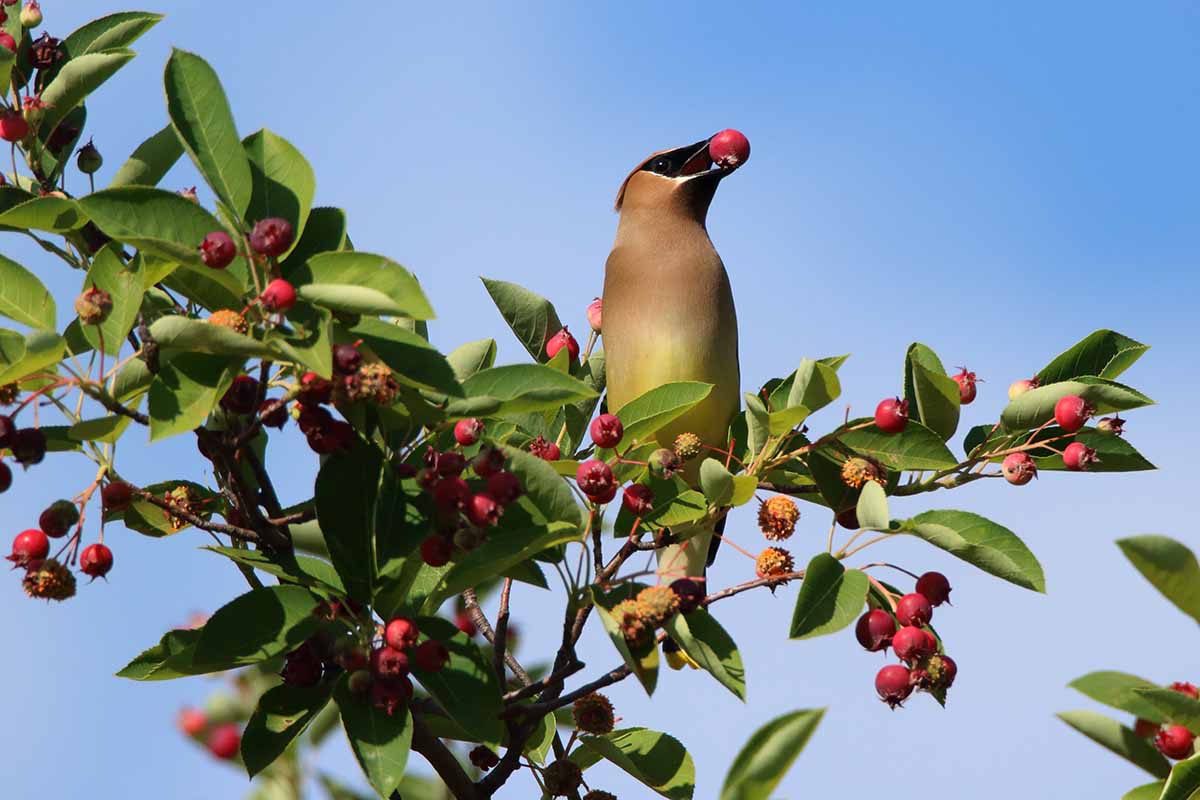

I use bird netting to protect my serviceberry and other fruiting shrubs like haskaps and shrub cherries. When I see the fruits are nearing maturity, I carefully spread the netting over the top of the plant.
Birds can easily find their way under the netting if it isn’t secured below, so depending on the form of your tree or shrub, there are a couple of ways to do this.
If your serviceberry is a multi-stemmed shrub, you can drape the netting all the way down to the ground and stake or place rocks on top of the edges of the drape at ground level.
In the case of a single trunk specimen, you can gather the netting and tie it gently around the trunk.
If your shrub or tree is too tall for you to reach over the top, you might want to consider pruning it to keep it more manageable or choose a couple of lower branches or sections to cover instead.
Insects
Serviceberry trees and shrubs attract a few different insect pests, which can also vector disease. Let’s take a closer look at the most common ones.
Aphids
Aphids are common insects found in our gardens and in most cases, they don’t cause enough damage to affect the health of the plant.
In severe cases, their feeding can cause stunted growth and leaves to twist, curl, and yellow.
Aphids are tiny, soft-bodied insects that are only about two to four millimeters in length. They range in color from brown, black, gray, green, red, or yellow. They shed their skins as they grow and these white dusty flakes can be seen on leaves.
These sap-sucking bugs feed on new, young growth and unopened flower buds and can often be seen on the underside of young leaves. As they feed, they secrete a sticky waste product called honeydew that can attract ants and yellowjackets.
Honeydew can also encourage the growth of sooty mold fungus, so it’s a good idea to manage aphid populations before they get out of control.
Some cultural control methods to discourage aphid infestation are to be diligent about removing weeds, and introduce and encourage natural predators like ladybugs, which like to eat aphids.
Soft-bodied aphids are also easy to squish and can’t survive a high-pressure spray from a garden hose.
If aphids persist, I recommend an application of neem oil, insecticidal soap, or horticultural oil to disrupt their feeding and life cycles.
Blister Mites
Like most eriophyid mites, blister mites (Phytoptus spp.) are microscopic and can only be seen with the help of magnification. They are typically identified by the damage they cause, which is patches of discoloration and deformities on leaves and fruit.
Blister mites attack other trees and shrubs like hawthorn, cotoneaster, and quince, so if you have these nearby, and you notice symptoms of infestation, check all of these plants as well.
In home orchards, these mites are not considered a major pest as they can usually be easily managed. Biological control methods like the introduction of natural predators are effective, as well as dormant spraying.
Dormant spraying is performed in late winter and very early spring before plants break dormancy. This helps to control pests and disease that may be overwintering on and around the plants.
In my orchard, I apply a mixture of organic liquid fish hydrolysate, liquid kelp, black strap molasses, neem oil, and insecticidal soap.
You can try a product like Monterey Horticultural Oil available from Arbico Organics, according to package instructions.
Pear Slug Sawflies
Although they might look like slugs, pear slug sawflies are not true slugs. They are larvae of the sawfly, Caliroa cerasi.
The larvae are orange to green in color, shaped like a tadpole, and up to half an inch in length.
They usually appear shiny and wet because they’re covered in their own liquid waste. The adult flies are thick-bodied, quarter-inch black wasps that don’t sting.
Their feeding skeletonizes the leaves and if an infestation is severe, the foliage will turn brown and shrivel.
Generally, the damage is mostly cosmetic, but if you want to preserve the ornamental value of your serviceberry, you’ll want to get rid of these bugs.
If you’ve identified larvae on your plants, apply neem oil or insecticidal soap, spraying the foliage according to instructions on the package.
Shothole Borer
Shothole borer, Scolytus rugulosus, is a type of bark beetle known to attack fruit trees like mulberry and serviceberry.
These beetles usually only target stressed or wounded trees, so if your plants are healthy and maintained properly, these bugs shouldn’t become an issue.
Adult shothole borer beetles are tiny, about three millimeters long, and brown to black in color. The larvae are cream colored or white.
Multiple generations of these beetles cycle in one year, and the larvae overwinter under the bark of trees, so they can be difficult to eradicate completely.
Shothole borers create tiny round holes in the bark where they burrow to lay their eggs. If your serviceberry appears weak or unhealthy, inspect the bark carefully for the presence of these holes.
Pesticides are generally not a recommended method of control for these beetles.
Infested branches should be pruned and burned and heavily infested specimens should be removed completely. Burn the material to stop the insects from moving to other trees or shrubs.
Spider Mites
The most common spider mite found on serviceberry is the European red mite, Panonychus ulmi.
These bugs aren’t actually insects, they’re more closely related to arachnids. They produce fine, silky webbing, which is a telltale sign of an infestation.
These tiny sap-sucking pests cause tiny yellow or white speckles to form on leaves. Eventually the leaves will turn a bronze color, dry, and drop. Heavily infested shrubs or trees can become stunted and even die.
A strong jet of water from your hose might be enough to destroy spider mites on your plants. If that doesn’t work, you can try introducing natural predators. Lacewings and ladybugs eat spider mites, and other predatory mites do too.
My next recommendation is to try insecticidal or miticidal oils and soaps. Dormant oils and horticultural oils used outside of dormancy are generally effective at eradicating spider mites.
These work through direct contact with the mites, so a couple of applications may be necessary to achieve good results.
Disease
Native plants like serviceberries are generally resistant to most diseases, but there are a few common ones to watch for in your home gardens and orchards. Let’s explore them together.
Fireblight
Often an issue for members of the Rosaceae family, fireblight can affect serviceberry shrubs and trees.
This disease can kill young shoots and flower blossoms, cause branch dieback, and in severe cases, the plants may die. It will also cause fruits to turn dark and shrivel on the stem.
This destructive, infectious disease is caused by the bacterium Erwinia amylovora.
It causes the bark at the base of branches to appear water soaked, then become dark, sunken cankers, and eventually dry.
Young twigs appear burned or a deep rust color. Dead leaves and fruit tend to remain attached to the branches.
Fireblight can spread to your healthy plants via insects, wind, rain, and your gardening tools.
To prevent this disease, make sure you clean and sanitize your gardening tools regularly, and always after using them on a plant known to be diseased.
Avoid heavy pruning and over-fertilization during the summer. Prune out any branches that are infected with fireblight to stop it from spreading through the plant’s vascular system.
There are no effective chemicals that will control this disease. If the infection reaches the trunk, this disease cannot be cured and you should remove the whole tree or shrub, including the stump.
If you’ve had plants with a previous fireblight infection in your gardens or home orchard, you can preventatively treat nearby trees and shrubs with a copper fungicide.
Powdery Mildew
Powdery mildew is a common fungal disease found on many plants in the home garden.
The infection causes spots or patches to form on leaves and stems of plants. These patches will appear white or grayish in color and sometimes fuzzy.
Powdery mildew is prolific in humid conditions and is more common in the spring and fall when the nights are cool, but it can occur during the summer as well.
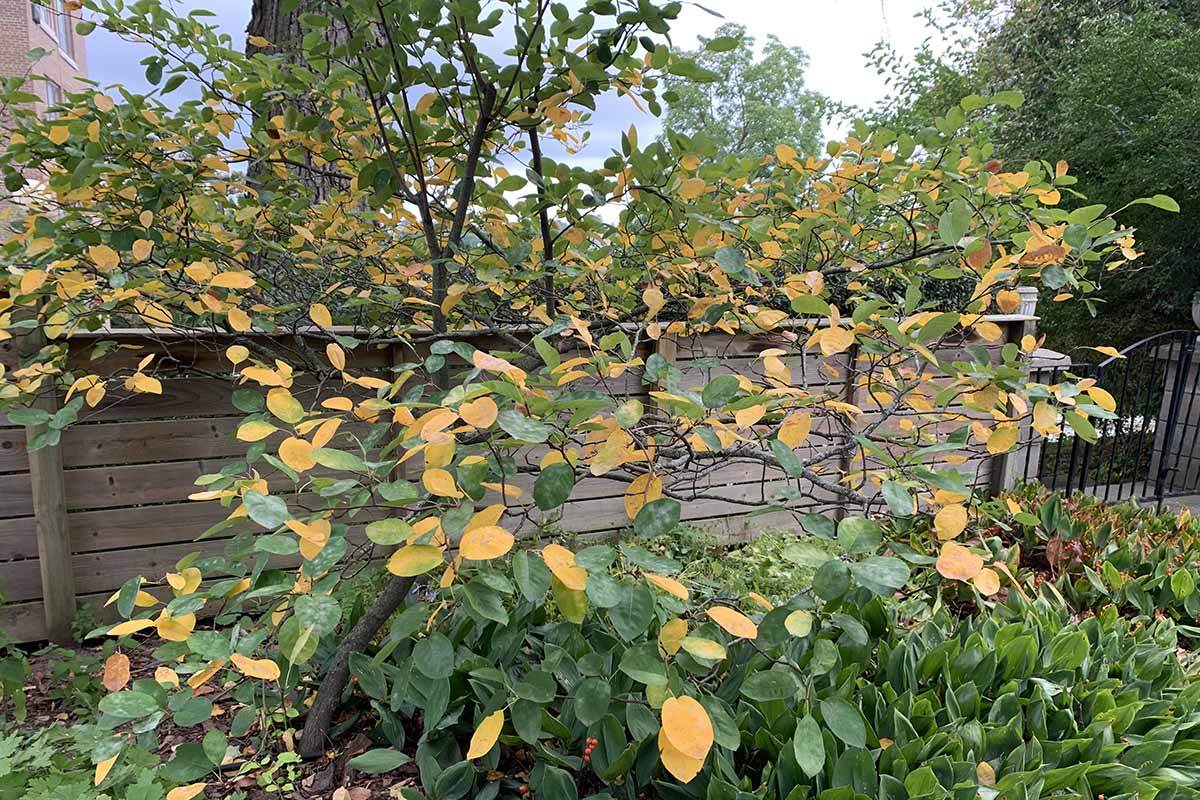

This disease, although unsightly, isn’t a big concern for established trees and shrubs. It rarely affects the health of the plant.
The best way to prevent powdery mildew is to ensure good air circulation by spacing plantings correctly and pruning as needed.
Fungicides can be sprayed if desired, but avoid spraying on fruits and always follow the label instructions.
Learn more about how to deal with powdery mildew in our guide.
Rust
Gymnosporangium rusts are common in members of the Rosaceae family, which includes serviceberry.
The fungal pathogen requires two hosts to complete its life cycle – one from the Rosaceae family and one from Cupressaceae family, which includes cedars and other junipers.
On the serviceberry, symptoms appear as bright orange spots on the leaves and damage is considered aesthetic, meaning that the spots just look bad if the infection is extreme.
To control rust on your serviceberry, remove damaged foliage and branches if necessary. Then inspect any nearby junipers for galls and symptoms in the late fall through winter and remove those affected branches.
Harvesting Serviceberries
Harvesting serviceberries is a simple process that rewards you with delicious fruits ideal for eating fresh or for use in cooking.
The berries are generally ready to harvest in June or July in the US, which is about 45 to 60 days after the plants bloom in early spring.
You’ll know they’re ripe when they turn a dark blue, purple, or nearly black color, resembling blueberries, and have a mild, sweet taste. Taste a few before picking all your berries just to be sure.
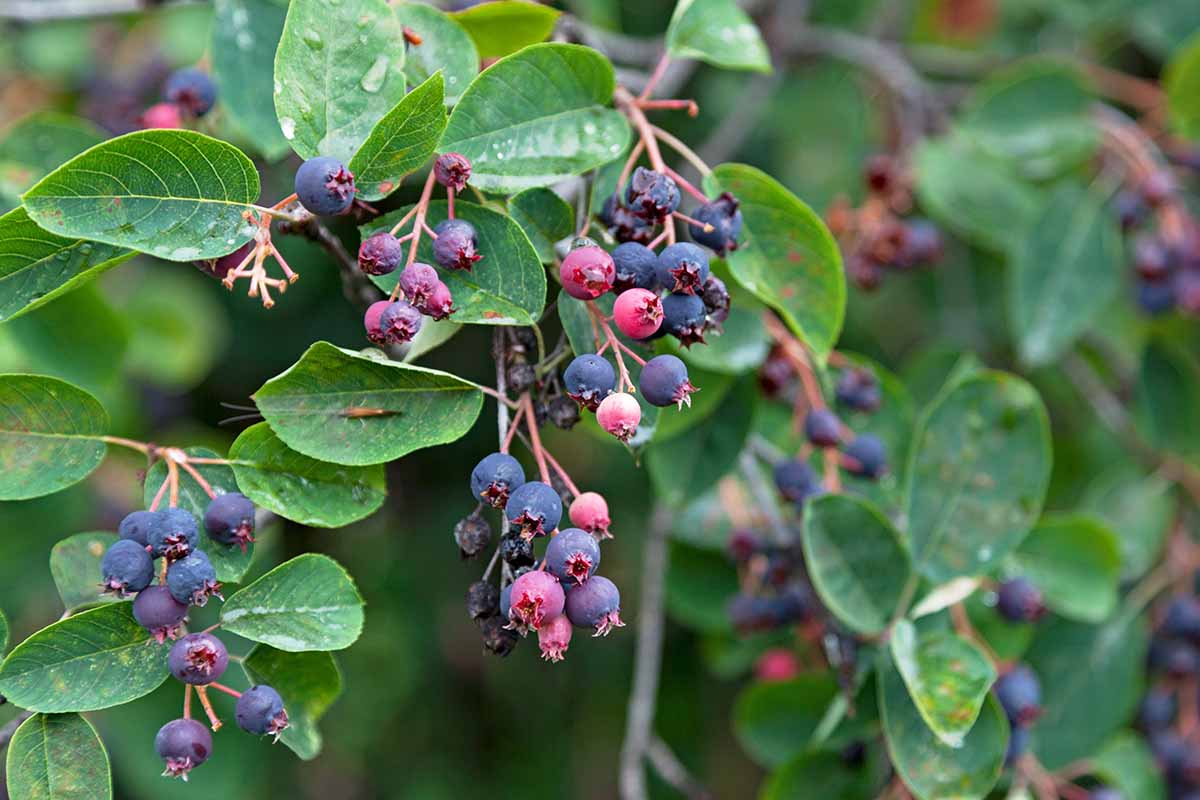

I recommend picking by hand in the morning after the dew has evaporated but before the day heats up, as this is when the fruit is firm rather than mushy. When they’re too soft, the berries can be difficult to pick.
Since serviceberries continue to ripen after being picked, you can choose to harvest them a little early to prevent the fruit from becoming too soft. The optimal time is when about two-thirds of the fruit on your tree or shrub are ripe.
Be mindful that birds and other wildlife also find serviceberries attractive, so as I mentioned before, it may be necessary to use bird netting to protect your harvest.
After picking, the serviceberries should be washed and then used or stored immediately for best flavor and texture.
Storing and Preserving
To ensure your serviceberries maintain their quality for as long as possible after harvest, you should first sort them, removing any debris, leaves, or damaged berries.
Next, in a strainer, rinse the berries under cool running water and then gently pat them dry with a clean towel.
I let my berries air dry before storing by spreading them on a clean towel on the counter for an hour or so. This helps the residual moisture from the rinsing to evaporate.
If you don’t plan to use your berries right away, once they’re dry, you can keep them in the vegetable drawer of your refrigerator for up to two weeks.
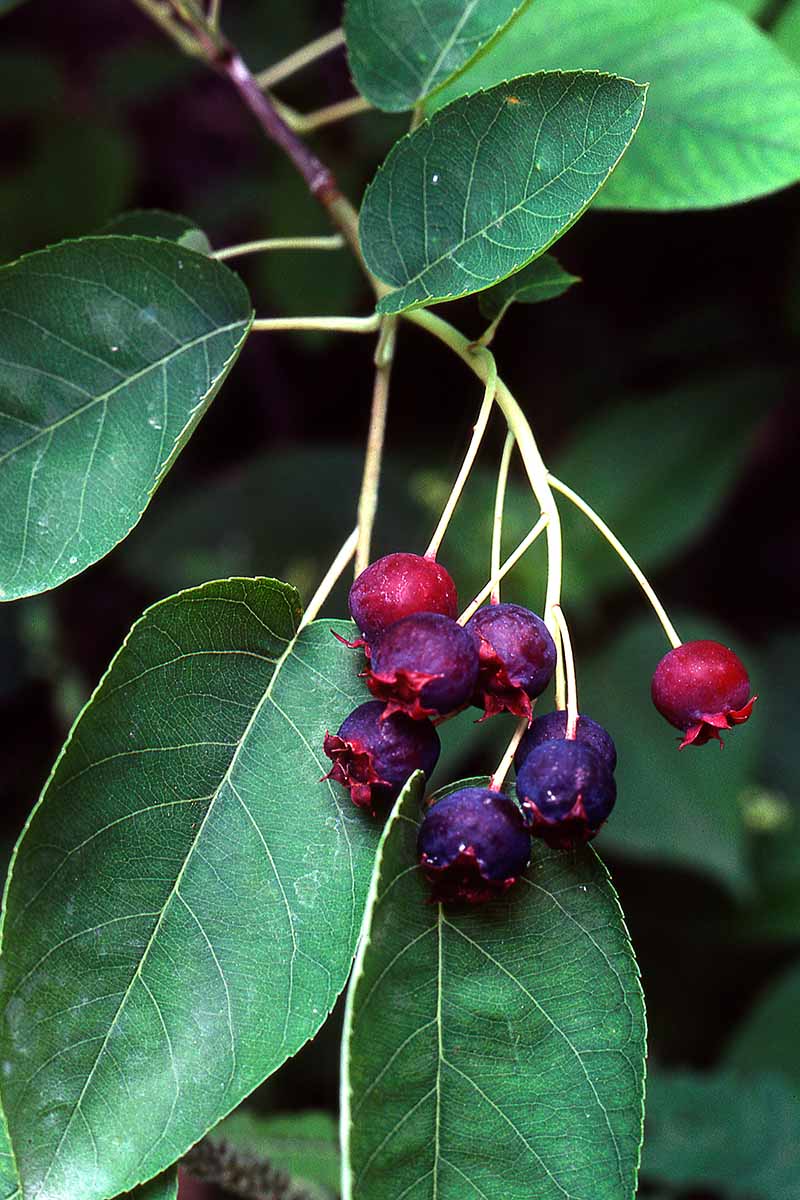

One of the most effective methods for storing serviceberries for an extended period is freezing.
To freeze serviceberries, first arrange cleaned berries in a single layer on a baking sheet lined with parchment paper.
Pop the sheet into the freezer until the berries are frozen and firm then transfer them into an airtight container or resealable plastic bag and keep them in the freezer.
You can store these frozen berries for up to a year or more.
Another storage method for serviceberries is dehydration. Spread your clean berries on a dehydrator tray or a lined baking sheet.
Dehydrate them at a low temperature, around 135°F or 57°C, for eight to 12 hours until they are completely dry and slightly leathery.
Allow the berries to cool and then store them in airtight containers or plastic resealable bags. Dehydrated serviceberries will keep for several months up to a year in a cool, dark place.
Recipes and Cooking Ideas
Ripe serviceberries are sweet and sometimes have a hint of nuttiness to them, which makes them a tasty choice for both sweet and savory dishes. Some people claim to love these berries more than blueberries!
You can use these fruits in any recipe that calls for blueberries. Of course, you can make jams, jellies, and syrups as you might with other berries or fruit.
Substitute the blueberries with serviceberries in this spiced blueberry jam recipe from our sister site, Foodal for a mouth-watering spread or filling.
All kinds of baked goods are fantastic with serviceberries as well, like pies, muffins, pastries, and breads. If you want to try something different, check out this recipe for maple blueberry coconut oil scones, also from Foodal.
Just swap out the blueberries with serviceberries for a warm and comforting treat.
If you’re interested in fermentation, these berries can be made into wine. They also add a sweet dimension to sauces and salad dressings.
You can also make fruit leather from serviceberries. With so many possibilities for use, it’s easy to understand why these berries are so popular!
Best Garden Uses for Serviceberries
Not only are the fruits of serviceberry delicious, but they’re a great source of nutrition. They’re high in fiber, as well as calcium, iron, magnesium, and manganese.
Aside from their health benefits and unique flavor, serviceberry plants have a myriad of uses in our landscapes and gardens.


Planted in groups, they can be used for hedging or screening, or impactful mass plantings.
They also make stunning focal points and specimen accents, including anchors for foundation plantings. Taller species also provide lovely shade.
With their aromatic flowers and abundant fruit, serviceberries make an excellent choice for pollinator gardens and native reclamation projects, attracting bees, birds, and other wildlife.
Their strong roots are also good for controlling erosion. They also happen to be tolerant of juglone. Bonus!
Quick Reference Growing Guide
| Plant Type: | Flowering deciduous tree or shrub | Flower / Foliage Color: | White/green (spring and summer), yellow, orange, red (fall) |
| Native to: | Africa, Asia, Europe, North America | Water Needs: | Moderate |
| Hardiness (USDA Zone): | 2-9 | Maintenance: | Low once established |
| Bloom Time/Season: | Spring, summer | Tolerance: | Air pollution, clay soil, juglone |
| Exposure: | Full sun to part shade | Soil Type: | Clay, loamy, sandy |
| Time to Maturity: | 10-20 years | Soil pH: | 5.5-7.0 |
| Spacing: | Width of mature spread | Soil Drainage: | Well-draining |
| Planting Depth: | Depth of root ball (transplants) | Attracts: | Birds, butterflies |
| Height: | 4-45 feet, depending on species | Uses: | Banks and slopes, cottage gardens, food forests, native gardens, ornamental focal points, wildlife gardens, woodland gardens; jams, jellies, pies, wine |
| Spread: | 4-30 feet, depending on species | Family: | Rosaceae |
| Growth Rate: | Varies depending on species | Genus: | Amelanchier |
| Pests & Diseases: | Borers, leaf miner, sawfly, scale; fire blight, leaf spot, powdery mildew, rust | Species: | Alnifolia, amabilis, arborea, asiatica, bartramiana, canadensis, covillei, cusickii, fernaldii, grandiflora, humilis, interior, intermedia, laevis, lamarckii, nantuckentensis, neglecta, obovalis, ovalis, pallida, parviflora, pumila, quinti-martii, sanguinea, sinica, spicata, stonolifera, turkestanica, utahensis |
Common But Definitely Full-Service
Whether you’re drawn to the delicate white spring blossoms and seasonally changing foliage, or you’re searching for more food-producing plants to add to your urban food forest, serviceberry has you covered.
And this article has you covered for everything you need to know about these trees and shrubs – from history and cultivation, to how to grow and care for your plants, and the best ways to use the berries in the kitchen.
Are you growing serviceberries? If you have a delicious recipe to share with me and our readers, please let us know in the comments section below.
And for more information about growing other types of berries in your garden, check out these guides next:
[ad_2]




